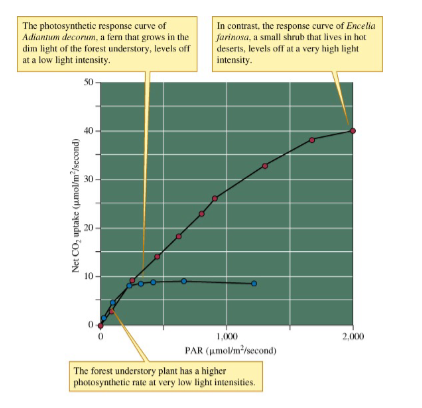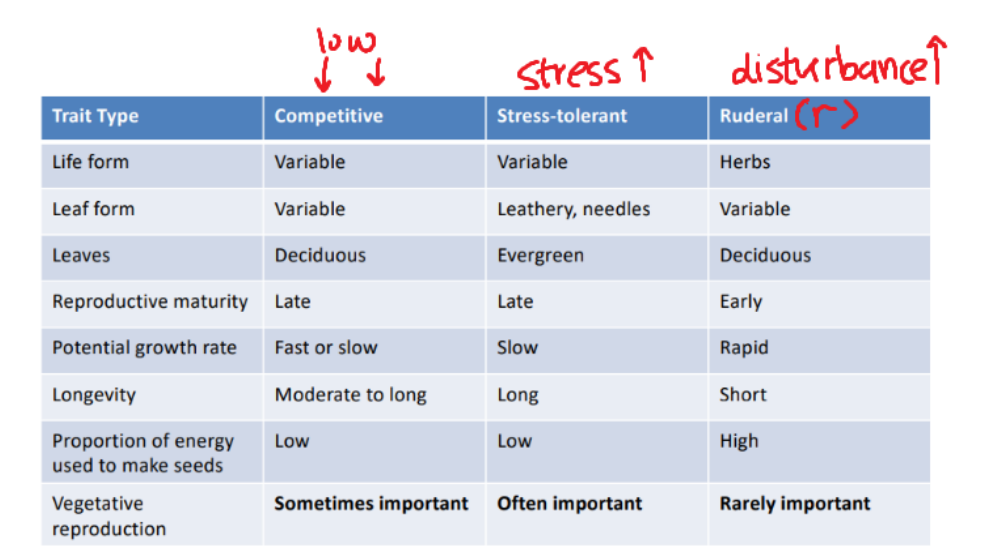EES 152: Ecology Exam 2
1/61
There's no tags or description
Looks like no tags are added yet.
Name | Mastery | Learn | Test | Matching | Spaced |
|---|
No study sessions yet.
62 Terms
blue
Within PAR. what color light is used most by photosynthesis?
45%
What percentage does PAR make up of all solar radiation?
photon flux density
What is PAR measured in?
ATP and NADPH
energy from these two molecules is used to build organic molecules, using CO2 as a carbon source
carbon fixation
the process in which inorganic carbon, usually in the form of CO2, is converted into organic molecules, including carbohydrates
C3, C4, and CAM
What are the three was photosynthesis is done?
mesophyll cells
Where do all C3 reactions take place?
rubisco
In C3 plants, what enzyme is used to initially fix CO2?
open; large
Do C3 plants need to keep their stomata open or closed? Do they have a small or large amount of stomata?
mesophyll and bundle sheath cells
What two different cells are involved or related to C4 plants?
pepco
In C4 plants, what enzyme is used to initially fix CO2?
less
Compared to C3 plants, do more or less stomata need to be open to bring in the same number of CO2 molecules in C4 plants?
lacking in C3 plants; present in C4 plants
Do the bundle sheath cells in C3 plants have chloroplasts? What about in C4 plants?
CAM plants
plants where stomata close during the day and open at night
lower temperatures reduce the vapor pressure deficit
Why do CAM plants fix carbon at night?
mesophyll, PEP
All reactions in CAM plants occur in ______ cells, like C3 plants, but CO2 is combined initially with _______, like C4.
large vacuoles in mesophyll cells
CAM plant leaves have what?
pepco
In CAM plants, what enzyme is used to initially fix CO2?
C3 plants are more competitive; C4 inefficient at low light intensities, ineffective as shade plants, takes more energy
Why aren’t C4 plants more abundant than C3 plants?
shaded regions: C4 does poorly (less light); C3 does well; opposite for sunny habitats
Plants that occur in shaded habitats versus a plant that occurs in open, sunny habitats. Difference between a C4 and C3 species in these conditions?
the rate is limited
The rate at which photosynthetic organisms can take in energy always levels off with increasing light. What does this mean?

true
TRUE OR FALSE: The current rise in CO2 has potential direct effects on energy acquisition and nutrients
heterotrophs
organisms that obtain their energy by capturing organic molecules manufactured by other organisms
93-97%
How much of biomass is made up of CHONP?
nitrogen
Which nutrient is particularly limiting?
carbon
What other element do ecologists use in ratio with nitrogen?
food
C:N ratio describes the quality of what to consumers?
describes quality of food (plants have high C:N; animals, fungi, bacteria have low C:N)
herbivores need to eat more plants to get enough N and energy; N is used to make DNA, RNA, proteins
Why does the C:N ratio of a food source matter?
toxins and chemical defenses (in tropical plants: mustard oil, capsaicin), symbiosis with ants and trees
What adaptaions have plants developed in response to herbivory?
cellulose; it is not digestible by any animal
What defense do ALL plants have against herbivores, and why?
nitrification
the oxidation of ammonia (NH4) to nitrite (NO2-) to nitrate (NO3-)
camouflage, spines and shells, repellents and poisons, behavior
What defenses have prey evolved in response to predation?
Mullerian mimicry
two or more toxic or harmful species evolve to resemble each other’s warning signals, such as the same pattern or bright colors
Batesian mimicry
a harmless species resembles a harmful one
type I functional response
feeding increases linearly with food supply up to a point and then levels off abruptly; only animals that need little to no time to process food
type II functional response
feeding increases linearly at low densities, rises more slowly at intermediate densities, and then levels off at high densities
time spent finding food
At low food density, feeding rate is limited by what?
time spent finding and handling food
At mid-food-density, feeding rate is limited by what?
time spent handling food
At high food denisty, feeding rate is limited by what?
type III functional response
S-shaped curve; low densities may afford prey more protected hiding spaces
type II
What type functional response is most common?
principle of allocation
a principle that states an organism has a limited quantity of resources that it can use for life processes
How does the principle of allocation relate to life histories and what trade-offs exist?
greater energy expenditure
High mortality rate; reproduction at earlier age. What does this mean in terms of energy expenditure?
semelparous
breeds once
iteroparous
breeds multiple times
r-selection
reproduce rapidly, high mortality, rapid turnover of generations, many offspring, semelparity
k-selection
at carrying capacity, stable, large, late maturity, iteroparity
intensity of disturbance (process limiting plants by destroying biomass); intensity of stress (external constraints limiting rate of growth
What variables are important in Grime’s life history classification of plants? What are the three end-member categories, what are their characteristics, and how are they related to environmental conditions? Compare and contrast Grime’s scheme with the classic r and k classifications.

distinct differences that results due to competition for mates
Define sexual selection.
intrasexual selection
males compete among themselves for mates (larger size, antlers)
intersexual selection
females choose mates based on particular traits (peacock tail feathers; good health hypothesis)
Define the handicap hypothesis